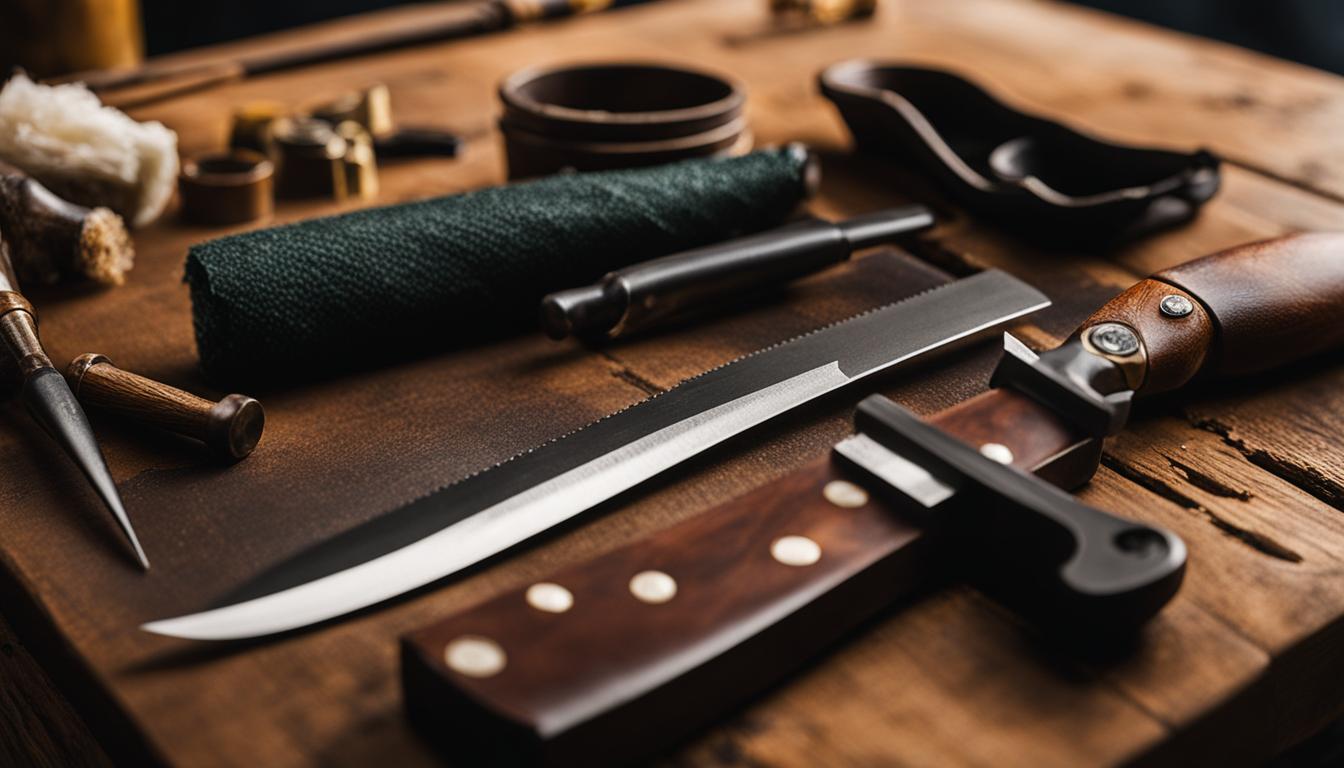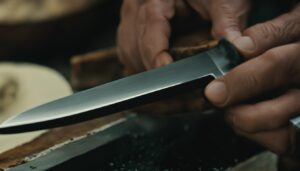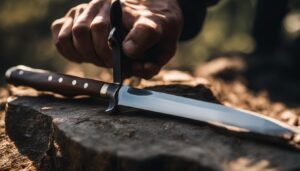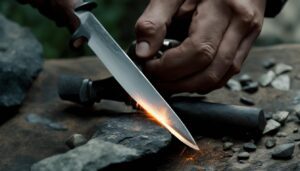As a hunter, I understand the importance of having a sharp hunting knife. It’s not just about owning the right equipment or honing your hunting skills; maintaining your hunting knife’s sharpness is equally vital. Over time, the blade can lose its edge, making it less effective and potentially compromising your safety in the field. That’s why I’ve put together these essential hunting knife maintenance tips to help you keep your blade razor-sharp.
Key Takeaways:
- Properly preparing your hunting knife before sharpening is crucial.
- There are various types of sharpening tools available, such as sharpening stones and honing rods.
- Sharpening a hunting knife with a sharpening stone involves maintaining a consistent angle and using the appropriate grit.
- Honing a hunting knife involves using a honing rod to straighten the edge, rather than removing material.
- Regular maintenance and care, including proper storage and regular sharpening, will prolong the lifespan of your hunting knife.
How to Sharpen a Hunting Knife Using a Sharpening Stone
Sharpening a hunting knife is an essential skill for any hunter looking to maintain the sharpness and effectiveness of their blade. One of the most traditional and widely used methods is sharpening with a sharpening stone. This technique requires precision and attention to detail to achieve the desired results.
To begin sharpening your hunting knife using a sharpening stone, start by securing the stone on a flat surface. This will provide stability and prevent the stone from moving during the sharpening process. Next, hold the knife blade against the stone at the desired angle. It’s important to maintain a consistent angle throughout the process to ensure an even and sharp edge.
Apply light pressure and move the blade back and forth in a sweeping motion along the length of the stone. This motion helps to evenly grind and sharpen the blade. Remember to use the appropriate grit of the sharpening stone based on the blade’s condition. A medium grit stone, typically ranging from 150 to 220 grit, is ideal for removing minor nicks and dullness without removing excessive material from the blade.
Once you have sharpened the hunting knife to your satisfaction, it’s recommended to use a honing rod to remove any burrs that may be present on the edge of the blade. This step helps to refine and polish the edge, resulting in a smoother and sharper cutting surface. With regular maintenance and proper sharpening techniques, you can ensure that your hunting knife remains in optimal condition for your outdoor adventures.
How to Sharpen a Hunting Knife Using a Honing Rod
Sharpening a hunting knife using a honing rod is an effective method to maintain its edge between sharpenings. The honing rod is a tool specifically designed to straighten the blade and restore its sharpness without removing material. Here’s a step-by-step guide on how to sharpen your hunting knife using a honing rod:
- Hold the honing rod securely, making sure it is slightly longer than the length of the knife. This ensures easier maneuverability and better results.
- Place the edge of the knife against the rod at the correct bevel angle. The angle can vary depending on the knife, typically around 20 degrees for most hunting knives.
- Using light pressure, pass the edge of the knife along the honing rod in a slow, precise motion. Maintain a consistent angle and ensure the entire length of the blade makes contact with the rod.
- Repeat this process on both sides of the knife, alternating between each side for an equal number of strokes. This helps achieve an even edge and prevents one side from becoming sharper than the other.
Honing your hunting knife regularly helps keep the edge aligned and prevents it from becoming dull. It’s important to note that honing does not replace sharpening; it is a supplementary maintenance step to be performed when the knife starts feeling less sharp. Honing rods are versatile tools that are easy to use and offer a quick way to maintain the performance of your hunting knife.
Remember to always exercise caution when sharpening and honing your hunting knife. Maintain a steady grip on the knife and use controlled motions to prevent accidents or injuries. With proper maintenance and care, your hunting knife will remain sharp and reliable, ensuring optimal performance during your hunting adventures.
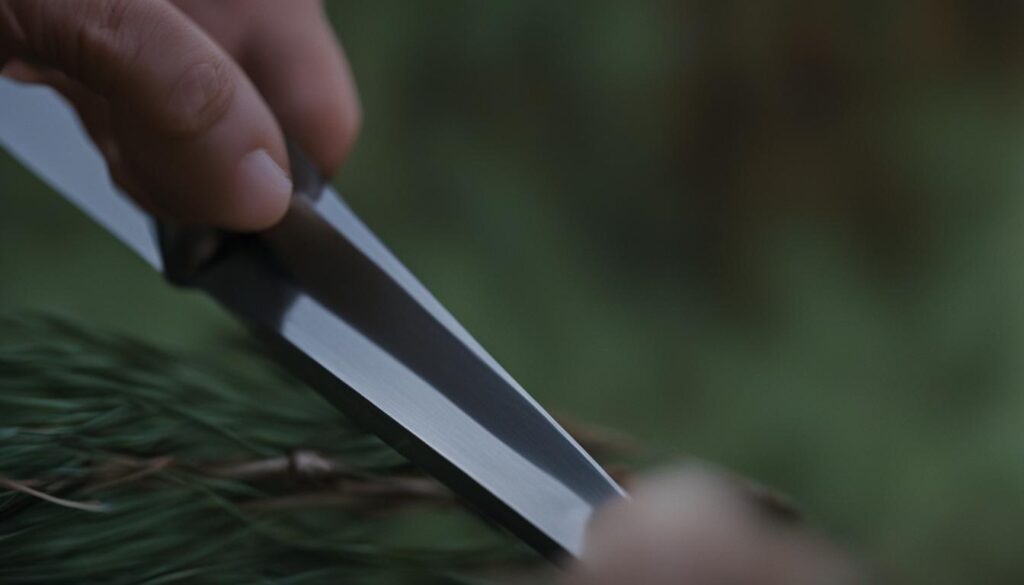
Ways to Maintain the Sharpness of Your Hunting Knife
Proper care and maintenance are crucial for preserving the sharpness of your hunting knife and ensuring its longevity. By implementing a few simple strategies, you can keep your knife in optimal condition for your hunting adventures. Here are some key ways to maintain the sharpness of your hunting knife:
1. Regular Honing:
Using a honing rod regularly between sharpenings can help maintain the edge of your hunting knife. Honing straightens the blade and removes any micro-damage that may have occurred during use. To hone your knife, hold the rod steady and gently pass the blade against it, ensuring the correct bevel angle. Light pressure and a slow, precise motion are essential for effective honing.
2. Proper Storage:
Storing your hunting knife properly is essential for preventing rust and degradation. Keep your knife in a dry place away from humidity, moisture, and extreme temperatures. Consider using a knife sheath or protective case to safeguard the blade from accidental damage. Additionally, make sure to clean and dry your knife thoroughly before storing it to avoid any moisture buildup.
3. Avoid Misuse:
Using your hunting knife for tasks it’s not intended for can damage the blade and reduce its sharpness. Avoid using the knife as a screwdriver, pry tool, or any other function outside of cutting and slicing. Using the knife for its intended purpose will help maintain its edge and prevent unnecessary wear and tear.
Implementing these maintenance practices will help prolong the sharpness of your hunting knife and ensure its effectiveness when you need it most. By regularly honing, properly storing, and avoiding misuse, you can keep your hunting knife in top shape for your hunting expeditions.
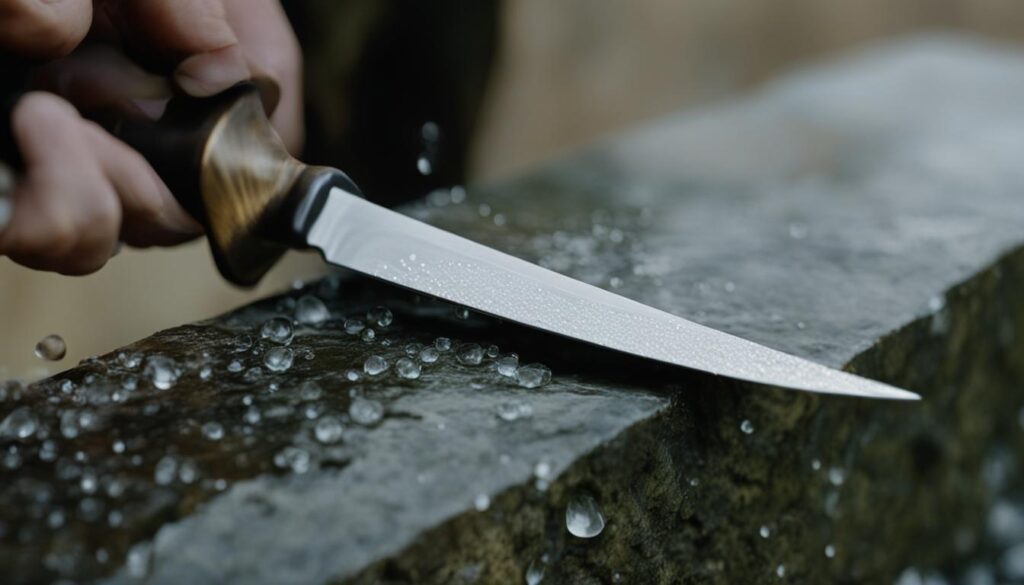

| Maintenance Tips | Benefits |
|---|---|
| Regular honing | Preserves the edge between sharpenings |
| Proper storage | Prevents rust and degradation |
| Avoiding misuse | Reduces wear and tear on the blade |
Conclusion
Properly maintaining and sharpening your hunting knife is crucial for optimal performance and safety. Sharpening should be done as needed, while honing helps maintain the edge between sharpenings. By following these hunting knife maintenance tips, you can ensure that your knife remains sharp and reliable in the field.
Choose the appropriate sharpening tool for your knife type and be mindful of the bevel angle. Different types of hunting knives require different sharpening techniques, so it’s important to find the method that works best for you. Regular maintenance and care, including cleaning, checking for damage, and proper storage, will also contribute to the longevity of your hunting knife.
Remember to use a honing rod to realign the edge between sharpenings and to store your knife in a dry place away from humidity, moisture, and extreme temperatures. Avoid using your knife for tasks it’s not intended for, as this can damage the blade. Regular sharpening is necessary to maintain the knife’s edge, with the frequency depending on how often you use the knife.
By implementing these hunting knife maintenance tips, you can prolong the lifespan of your knife and ensure its effectiveness in the field. Keep your hunting knife sharp and reliable, and it will serve you well during your hunting adventures.
FAQ
How often should I sharpen my hunting knife?
The frequency of sharpening your hunting knife depends on how often you use it. As a general guideline, you should sharpen it whenever it starts to feel dull, which could be after a few uses or several weeks of hunting. Regular maintenance and honing between sharpenings can help extend the time between sharpening sessions.
Can I use any sharpening tool for my hunting knife?
Different types of hunting knives require different sharpening techniques and tools. It’s important to choose the appropriate tool for your specific knife type. Sharpening stones, honing rods, electric sharpeners, pull-through sharpeners, and guided sharpening systems are all options to consider. Experimenting with different tools and techniques will help you find the best method for sharpening your hunting knife.
How do I know the right bevel angle for sharpening my hunting knife?
The bevel angle refers to the angle at which you hold the knife against the sharpening tool. The optimal bevel angle depends on the specific knife and its intended use. It’s recommended to consult the manufacturer’s guidelines or instructions for your particular knife to determine the appropriate bevel angle. Some knives have a pre-determined angle, while others allow for adjustment based on personal preference.
What is the purpose of honing a hunting knife?
Honing a hunting knife is a process that helps maintain the sharpness of the blade between sharpenings. It involves using a honing rod to straighten the edge of the blade, rather than removing material like sharpening. Honing is done when the knife starts to feel dull and helps keep the edge aligned and sharp. Regular honing can extend the time between sharpening sessions.
How should I store my hunting knife?
Proper storage is important to prevent rust and degradation of your hunting knife. Store it in a dry place, away from humidity, moisture, and extreme temperatures. Consider using a sheath or knife case to protect the blade and keep it safe. Avoid storing the knife with other metal objects that could cause scratches or damage.
